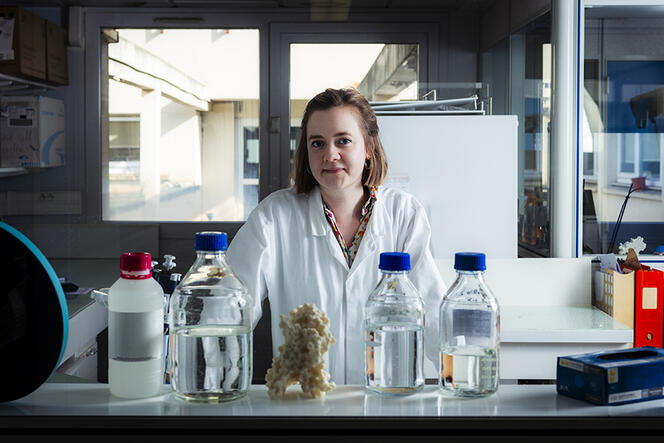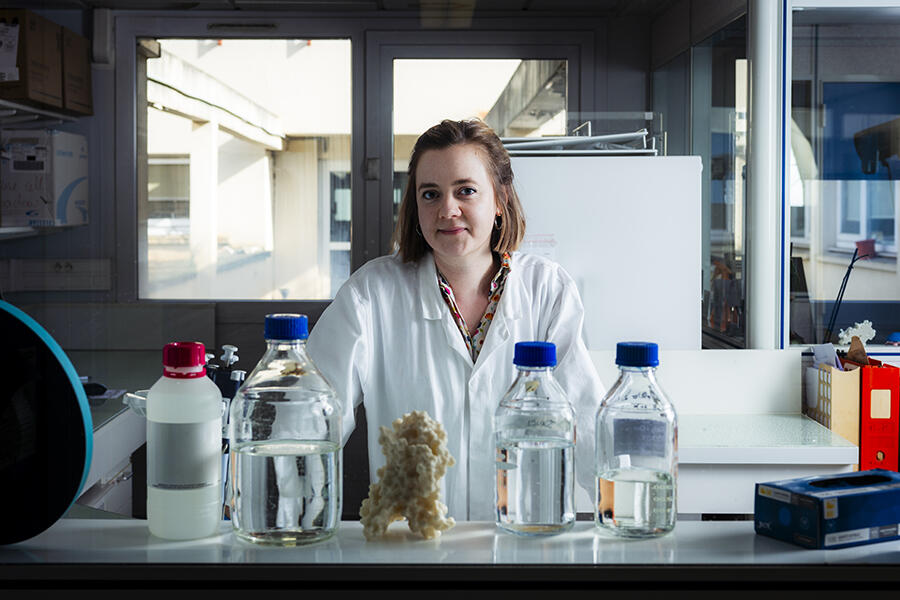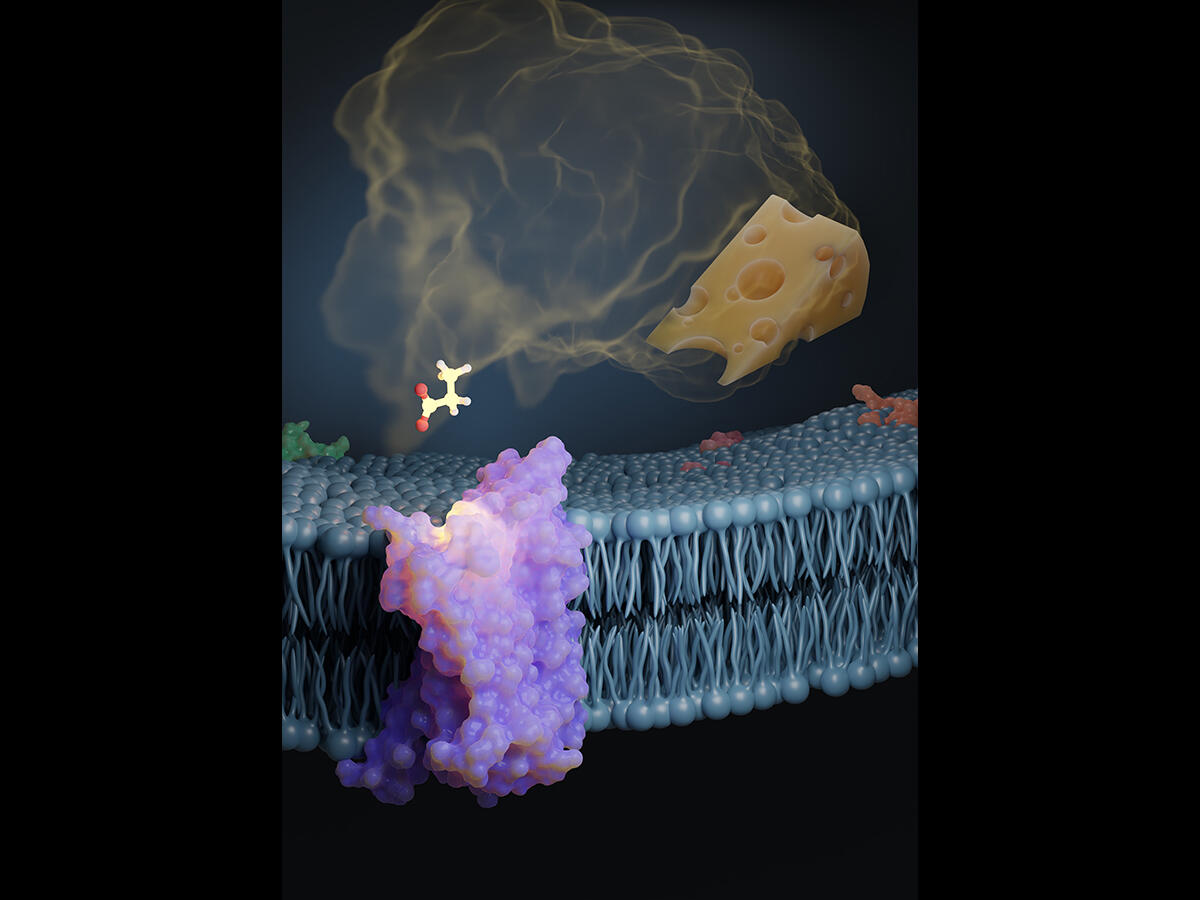You are here
Claire de March, a researcher with flair

Claire de March is a scientist with flair. In November 2023 she was awarded, along with four other laureates, the Irène Joliot-Curie “Young Woman Scientist of the Year” prize by the French Academy of Sciences. Several months earlier, with an international team, she had succeeded in developing the very first experimental structure of a human olfactory receptor. Until this breakthrough, research in olfaction relied on structures based on sight receptors – a hypothesis that may indeed be useful, but that cannot capture the complexity of the interactions between our neuronal system and the countless odours that inhabit our planet. “Before this discovery, we didn’t know anything about these receptors. Being able to publish a discovery like this is a researcher’s dream come true,” De March rejoyces.
A passion for scents, flavours and aromas
This award comes at a turning point, just three years after the global Covid-19 epidemic shone a spotlight on taste and smell disorders, underscoring the fact that science has yet to answer some of the most fundamental questions about the mechanisms of olfaction. It also came after years of dedicated effort, although De March has trouble pinpointing a specific moment when her passion for her subject matter was sparked. “I never seemed destined to love science or pursue this kind of career,” she recalls. “I had a very artistic childhood. My mother studied fine arts, my father was in electronics and my grandmother was a cashier. I wasn’t especially drawn to the image of the scientist, but in school I felt a real affinity for chemistry. What interests me is the complexity of mixtures and combinations.”
De March recalls childhood memories of cooking with her grandmother, picking out ingredients to compose her own recipes. “There were whiffs of vanilla and cakes wafting from the oven. Smells aren’t the kind of memories we often share with others, but they are important nonetheless.” To this day, the researcher can be carried away by the fragrance of patchouli, which reminds her of the perfume her mother used to wear when she was a child, or by the scents “that linger after a person has left the room”, like an olfactory signature.
Starting from secondary school, this proclivity for compositions naturally steered her towards a career in chemistry. De March sat her A levels in technology, but she wanted to take her studies further. After a long effort to “struggle back up the university pyramid”, she trained as a perfumer and flavourist in Versailles (near Paris). “I didn’t have the right diploma to even apply,” she admits. “I had to do the best I could with what I had. But I was lucky to have very nice teachers who helped me catch up as quickly as possible.”
Once she passed the exam, she began an internship in the food section at Bel Industries. Pursuing this channel was a deliberate choice at an age when most students would opt for a perfumery curriculum. “I never wanted my mixtures to smell nice,” she recounts. “I preferred the complexity of aromas and flavours.” She cites the example of the truffle: few people would like it as a perfume, but nearly everyone loves its flavour.
After completing a master’s degree, De March extended her studies with a thesis on computational chemistry at the University of Nice (southeastern France). She wanted to create a virtual model of the human nose, but was faced with a daunting challenge. “Although we know that humans have nearly 400 olfactory receptors in their noses, we were unable to reproduce the structure of even one of those on the atomic scale,” she explains. “I could only base my research on hypotheses.” She reached out to biologists and contacted Hiroaki Matsunami at Duke University in North Carolina (US), who had carried out the first in vivo tests of olfactory receptors in mice. Their exchanges proved to be a milestone in De March’s professional career.
Developing the first artificially-reproduced human olfactory receptor
After completing her thesis, she went to join Matsunami’s team in the United States, where she ended up staying for seven years. Under the senior scientist’s mentorship, De March learned to channel her boundless energy as well as her anxieties as a young researcher, gradually gaining self-confidence. “I learned that even though I couldn’t know everything it was no reason to question myself, and that as a scientist I also had the right to make mistakes.” This learning experience would prove useful: “When she arrived in December 2022, Claire joined a long-standing, well-established team. She rose to the challenge very well,” reports Carine Van Heijenoort, deputy director of the ICSN1 in Gif-sur-Yvette (near Paris), who describes De March as “a considerate, direct and open-minded co-worker”. Boris Vauzeilles, the institute director is of the same opinion: “She’s inspiring in the way she approaches her work. Her infectious enthusiasm gives everyone momentum".

It was this same determination that allowed her to produce the first artificial human olfactory receptor. Rather like the photosensitive cells in our eyes, which react to light wavelengths corresponding to distinct colours, an olfactory receptor can be sensitive to a range of chemical functions, allowing it to recognise a great many odorant molecules; but there are far more combinations for odours than for visible wavelengths.
In fact, an odorant molecule can activate several receptors, making it possible to distinguish a multitude of odours – and further complicating De March’s work. “It’s somewhat like a big piano: an odour is like a musical chord, which can be struck using multiple receptors that are analogous to the instrument’s keys, and a single key can be involved in a variety of musical chords,” she explains. To create this composition, the researcher observed the reactions to various chemical compounds of olfactory receptor OR51E2, and then reproduced its behaviour at the molecular level as a digital model.
This process could mark a turning point in our understanding of how we react to odours, explaining why the same smell can appeal to some people while leaving others completely indifferent. It also paves the way for the creation of new scents and aromas in fields like perfumery and the food industry. In addition, certain olfactory receptors are also involved in other biological processes, such as the release of serotonin in the intestine or prostate cancer. “Odorant receptors are becoming new potential therapeutic targets, especially in cancer treatments,” De March reports. “We don’t necessarily think that we can save the world by studying olfaction, but it could eventually happen!”
Recreating and activating prehistoric receptors
Another of De March’s scientific feats is the virtual recreation of an olfactory receptor of Denisovan Man, an extinct species of the genus Homo that lived more than 30,000 years ago – based on DNA sequences. “I really like history and archaeology, so this was a dream project for me,” the researcher recounts. “When I saw the receptor respond on my machine, it was a minor miracle. I remember thinking this was a receptor that hadn’t been activated by an odorant molecule for tens of thousands of years!” The chemist has also succeeded in virtually recreating the primeval receptors of the very first organisms capable of detecting odours, once again with the goal of facilitating future research in the science of olfaction.
De March has recently found inspiration in the scientific work of her colleagues, especially Vanessa Ruta, an American neuroscientist who is investigating odour recognition mechanisms in insects (“Impressive work, and right up my street,” she says) and Noam Sobel at the Weizmann Institute of Science in Israel, whose research sheds light on the cerebral mechanisms of the human olfactory system and their key role in our social interactions and emotions.
In addition to being an accomplished scientist, De March is also a fervent advocate of better integration of women in the world of research. Immediately upon arriving at the ICSN, she joined its equality-parity-inclusion unit. “Real change is only just beginning, and it’s still difficult for women to pursue a career in the sciences,” she laments. She also regrets that female scientists have so few role models to emulate. “Fortunately, in olfaction research we have a Nobel Prize laureate, Linda Buck!” 2 she adds. One day Claire de March’s talents may in turn inspire a new generation of women researchers. ♦
For further reading and viewing on our website
How to improve care for anosmia patients?
Cracking the olfactory code

















